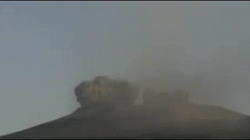Santorini’s Bronze Age Eruption
 Ten years of intensive scientific study of volcanic activity on Santorini shows that the south Aegean island has experienced a much more violent history than was previously suspected. Volcanologists now believe the cataclysmic Bronze Age eruption, which they date to 1630 BC (+/- 1 year), was in fact not responsible for exposing the stratified, multi-coloured cliffs which inspire such awe in visitors sailing into the enormous caldera.
Ten years of intensive scientific study of volcanic activity on Santorini shows that the south Aegean island has experienced a much more violent history than was previously suspected. Volcanologists now believe the cataclysmic Bronze Age eruption, which they date to 1630 BC (+/- 1 year), was in fact not responsible for exposing the stratified, multi-coloured cliffs which inspire such awe in visitors sailing into the enormous caldera.
Instead, scientists declare that the relatively recent event left merely the light-coloured, 60-metre-thick pumice and volcanic ash (or tephra) topping, clearly discernible above the 300-metre-deep remains underneath. Lower levels were deposited earlier, they say, by a dozen or so successive major eruptions spanning some 700,000 years, a specially huge one occurring about 120,000 years ago.
Memorable eruptions spewing out up to 40 cubic kilometres of pyroclastic material and shredded molten rock are now deduced on geological grounds to happen once every 20,000 years or so. Prior to the Bronze Age eruption famous for burying the town of Akrotiri, the two most recent were 18,000 and 36,000 years ago. The conspicuous remnant of the earliest of these three explosions is the jaggedly grotesque lava outcrop known as Skaros, which juts up from the clifftop at Imerovigli, north of Fira, Santorini’s main town.


No comments yet.